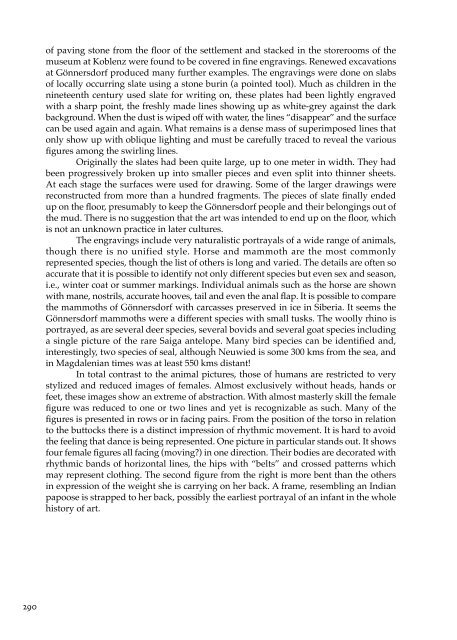The Spirit in Human Evolution - Waldorf Research Institute
The Spirit in Human Evolution - Waldorf Research Institute
The Spirit in Human Evolution - Waldorf Research Institute
You also want an ePaper? Increase the reach of your titles
YUMPU automatically turns print PDFs into web optimized ePapers that Google loves.
290<br />
of pav<strong>in</strong>g stone from the floor of the settlement and stacked <strong>in</strong> the storerooms of the<br />
museum at Koblenz were found to be covered <strong>in</strong> f<strong>in</strong>e engrav<strong>in</strong>gs. Renewed excavations<br />
at Gönnersdorf produced many further examples. <strong>The</strong> engrav<strong>in</strong>gs were done on slabs<br />
of locally occurr<strong>in</strong>g slate us<strong>in</strong>g a stone bur<strong>in</strong> (a po<strong>in</strong>ted tool). Much as children <strong>in</strong> the<br />
n<strong>in</strong>eteenth century used slate for writ<strong>in</strong>g on, these plates had been lightly engraved<br />
with a sharp po<strong>in</strong>t, the freshly made l<strong>in</strong>es show<strong>in</strong>g up as white-grey aga<strong>in</strong>st the dark<br />
background. When the dust is wiped off with water, the l<strong>in</strong>es “disappear” and the surface<br />
can be used aga<strong>in</strong> and aga<strong>in</strong>. What rema<strong>in</strong>s is a dense mass of superimposed l<strong>in</strong>es that<br />
only show up with oblique light<strong>in</strong>g and must be carefully traced to reveal the various<br />
figures among the swirl<strong>in</strong>g l<strong>in</strong>es.<br />
Orig<strong>in</strong>ally the slates had been quite large, up to one meter <strong>in</strong> width. <strong>The</strong>y had<br />
been progressively broken up <strong>in</strong>to smaller pieces and even split <strong>in</strong>to th<strong>in</strong>ner sheets.<br />
At each stage the surfaces were used for draw<strong>in</strong>g. Some of the larger draw<strong>in</strong>gs were<br />
reconstructed from more than a hundred fragments. <strong>The</strong> pieces of slate f<strong>in</strong>ally ended<br />
up on the floor, presumably to keep the Gönnersdorf people and their belong<strong>in</strong>gs out of<br />
the mud. <strong>The</strong>re is no suggestion that the art was <strong>in</strong>tended to end up on the floor, which<br />
is not an unknown practice <strong>in</strong> later cultures.<br />
<strong>The</strong> engrav<strong>in</strong>gs <strong>in</strong>clude very naturalistic portrayals of a wide range of animals,<br />
though there is no unified style. Horse and mammoth are the most commonly<br />
represented species, though the list of others is long and varied. <strong>The</strong> details are often so<br />
accurate that it is possible to identify not only different species but even sex and season,<br />
i.e., w<strong>in</strong>ter coat or summer mark<strong>in</strong>gs. Individual animals such as the horse are shown<br />
with mane, nostrils, accurate hooves, tail and even the anal flap. It is possible to compare<br />
the mammoths of Gönnersdorf with carcasses preserved <strong>in</strong> ice <strong>in</strong> Siberia. It seems the<br />
Gönnersdorf mammoths were a different species with small tusks. <strong>The</strong> woolly rh<strong>in</strong>o is<br />
portrayed, as are several deer species, several bovids and several goat species <strong>in</strong>clud<strong>in</strong>g<br />
a s<strong>in</strong>gle picture of the rare Saiga antelope. Many bird species can be identified and,<br />
<strong>in</strong>terest<strong>in</strong>gly, two species of seal, although Neuwied is some 300 kms from the sea, and<br />
<strong>in</strong> Magdalenian times was at least 550 kms distant!<br />
In total contrast to the animal pictures, those of humans are restricted to very<br />
stylized and reduced images of females. Almost exclusively without heads, hands or<br />
feet, these images show an extreme of abstraction. With almost masterly skill the female<br />
figure was reduced to one or two l<strong>in</strong>es and yet is recognizable as such. Many of the<br />
figures is presented <strong>in</strong> rows or <strong>in</strong> fac<strong>in</strong>g pairs. From the position of the torso <strong>in</strong> relation<br />
to the buttocks there is a dist<strong>in</strong>ct impression of rhythmic movement. It is hard to avoid<br />
the feel<strong>in</strong>g that dance is be<strong>in</strong>g represented. One picture <strong>in</strong> particular stands out. It shows<br />
four female figures all fac<strong>in</strong>g (mov<strong>in</strong>g?) <strong>in</strong> one direction. <strong>The</strong>ir bodies are decorated with<br />
rhythmic bands of horizontal l<strong>in</strong>es, the hips with “belts” and crossed patterns which<br />
may represent cloth<strong>in</strong>g. <strong>The</strong> second figure from the right is more bent than the others<br />
<strong>in</strong> expression of the weight she is carry<strong>in</strong>g on her back. A frame, resembl<strong>in</strong>g an Indian<br />
papoose is strapped to her back, possibly the earliest portrayal of an <strong>in</strong>fant <strong>in</strong> the whole<br />
history of art.
















